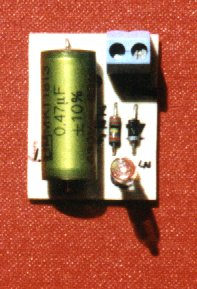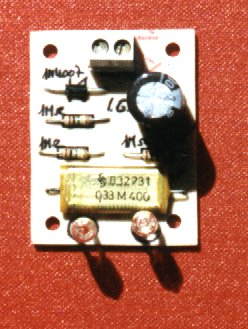



Now the lamp is fed with an unidirectional current and only the negative electrode glows.

Remark: Depending on the type of the lamp some variations to the values of the components can be required.


The diagram is very similar to the blinker: when the fuse is in order the two resistors (with the series diodes) are in parallel and the capacitor is charged very quickly since one of the resistor is only 150 KOhm (much smaller than the other one) and the lamp blinks very fast and gives the impression of being permanently lit. When the fuse blows the capacitor is charged only by the other resistor (of 2.2 MOhm) and the lamp now blinks slowly to indicate that the fuse has blown. If the main voltage drops the lamp remains off (obvious!).

| 
|
I suggest to insert, in series with the two resistors, two fast fuses to ensure that the circuit remains safe even if a component of the monitor breaks.


This is quite a critical circuit and requires two identical glow lamps. Not every lamp will work fine and some adjustments could be required. Not every lamp will work for this circuit.

Remark: This circuit will start working only a few seconds after it has been switched on, and, once switched off it will continue blinking for some seconds. The charge in the high voltage capacitor can be lethal even when the blinker is switched of: always discharge this capacitor before touching any part of the circuit!!!


This "instrument" has three ranges: 10, 100 and 1000 MOhm and the indications in the table below are only indicatives, since the exact values depends on the tolerances of the components and on the characteristics of the glow lamp. In that table all values are valid for the case of 10 blinks in 10 seconds:
| Range | Unknown resistor |
| C = 4.7 nF | Rx = 1000 MOhm |
| C = 47 nF | Rx = 100 MOhm |
| C = 470 nF | Rx = 10 MOhm |
This circuit is directly connected to the main voltage and should not be touched, even the leads and the unknown resistor!!!


| Back to the index. | 
| Back to the home page. |

| Previous page. | 
| Next page. |


| Questa pagina è anche disponibile in italiano. |
